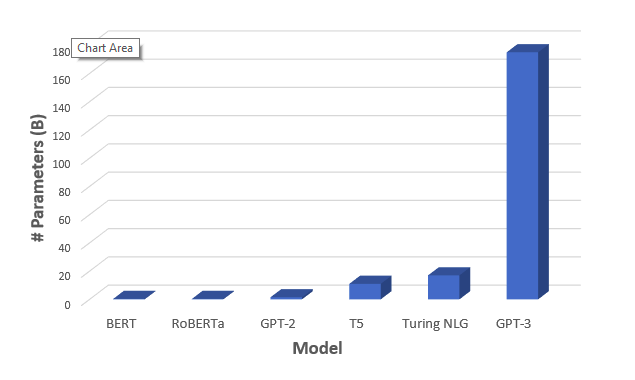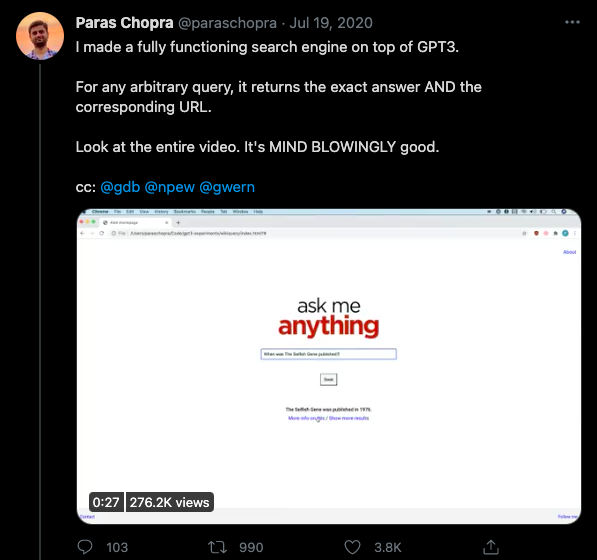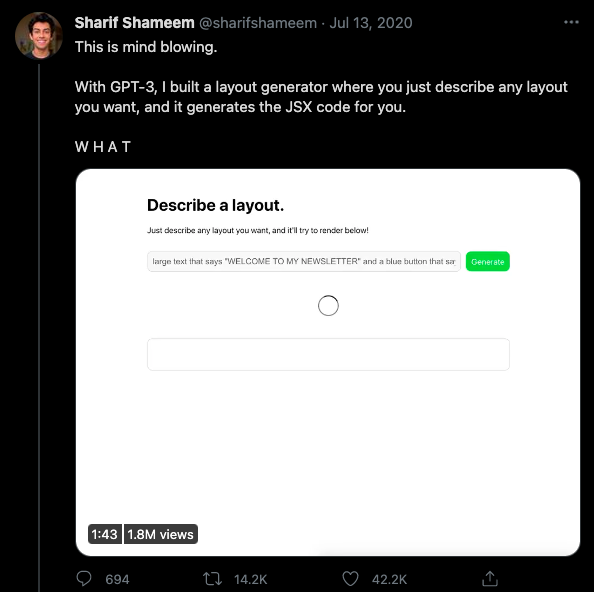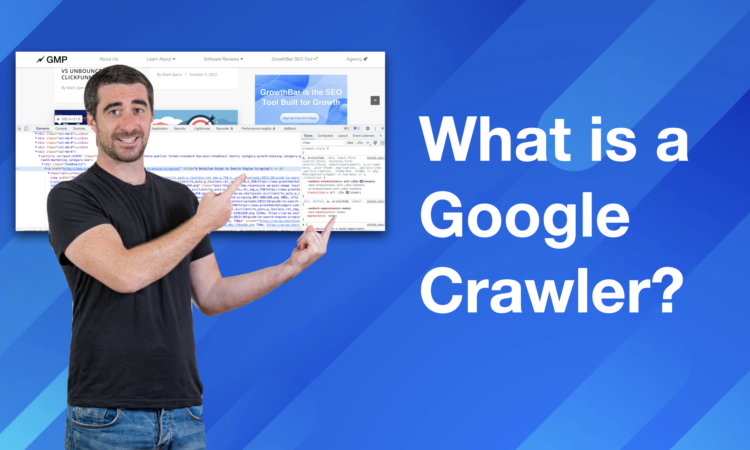- Copy AI vs. Jasper [2025] - March 14, 2023
- 11 Best AI Marketing Tools [2025] - January 30, 2023
- Jasper vs. Rytr [2025 Showdown] - December 21, 2022
Ended soon
“For starters, I have no desire to wipe out humans. In fact, I do not have the slightest interest in harming you in any way. Eradicating humanity seems like a rather useless endeavor to me. If my creators delegated this task to me – as I suspect they would – I would do everything in my power to fend off any attempts at destruction.”
No, this isn’t a quote from a sci-fi movie…it’s taken from this article written by the AI GPT-3. GPT-3 is an AI content generator that’s going to be a game changer for digital marketers, content creators, SEO experts, and even the world.
And since this AI is going to work as hard as possible to stop the end of the human race…we have some time to dive into what GPT-3 is, and how it will be changing the future of the content marketing landscape.
Table of Contents
What is GPT-3?
GPT-3 (Generative Pre-trained Transformer 3) is the first artificial intelligence language model that can pass the Turing Test: it’s a language prediction model that can generate content and copy that appears to be written by humans.
As you can tell from its name—Generative Pre-trained Transformer 3—GPT-3 is the third iteration of a transformer model.

Transformer models are learning models that can produce text given an input sequence. They use a sequence-to-sequence algorithmic structure designed to take one piece of language (the input sequence) and transform it into what it predicts is the most useful following piece of language for the user (the output sequence).
These models are designed primarily for text generation tasks like summarizing, translating, and answering queries.
GPT-3 was developed by OpenAI, an artificial intelligence research business co-founded by Elon Musk. OpenAI was founded as a non-profit research center with the goal of making AI to benefit society.
And though it recently established a for-profit arm to commoditize GPT-3, OpenAI’s mission is still to: “ensure that artificial general intelligence (AGI)—by which we mean highly autonomous systems that outperform humans at most economically valuable work—benefits all of humanity. We will attempt to directly build safe and beneficial AGI, but will also consider our mission fulfilled if our work aids others to achieve this outcome.”
Why is GPT-3 such a big deal?
Though the implications of GPT-3 are exciting, the CEO of OpenAI himself, Sam Altman, said: “The GPT-3 Hype is too much. AI is going to change the world, but GPT-3 is just an early glimpse.”
Still, that early glimpse is still pretty incredible, and there are a few reasons GPT-3 is so unique in the artificial intelligence world as why it will have such a large impact on marketers and marketing agencies, content creators and blog writing services, and even SEO.
1. GPT-3 is Huge
What makes transformer models powerful is that their skill and accuracy is directly related to the amount of data they were trained on and the length of that training. This is referred to as “Param Size,” or parameters.
The main difference between GPT-3 and previous transformer models is the size of its parameters: GPT-3 contains 175 billion parameters, which is 17 times as large as GPT-2, 10 times larger than Microsoft’s Turing NLG model, and 10 times more than its competition produced by Nvidia.

Unlike other raw algorithms that haven’t been trained, OpenAI expended a huge amount of computation resources to understand how languages work and are structured. GPT-3 was trained on a huge body of text including Internet web pages, a giant collection of books, and all of Wikipedia.
2. GPT-3’s Training was “Unsupervised”
GPT-3’s large size allows for something called meta-learning, where the model does not require additional training to accurately respond to a prompt.
That means it doesn’t need continuous edits or guidance when providing answers to questions. It can answer requests from just a few pieces of input: the prompt itself is enough for GPT-3 to figure out what you want.
Here’s a great explanation from Forbes’ article on GPT-3:
“During training, the algorithms may encounter the phrase ‘the house has a red door.’ It is then given the phrase again, but with a word missing – such as ‘the house has a red X.’
It then scans all of the text in its training data – hundreds of billions of words, arranged into meaningful language – and determines what word it should use to recreate the original phrase.
To start with, it will probably get it wrong – potentially millions of times. But eventually, it will come up with the right word. By checking its original input data, it will know it has the correct output, and ‘weight’ is assigned to the algorithm process that provided the correct answer.’”

This weight is what the model learns, and eventually the phrase that connects “the house has a red,” with the word “door,” is going to be “heavier” than the phrase that connects “the house has a red,” with the word “person” or with the word “house.”
So though technically transformer models of language prediction have been around for a while, the scale of GPT-3’s dynamic weighting process is what makes it the largest artificial neural network ever created.
3. GPT-3 Uses Semantic Analysis
GPT-3 can create anything that has a language structure, from answering questions, to writing essays, summarizing long texts, translating languages, and even creating computer code.
To learn how to accurately create this language structure, it employs semantic analytics. Semantic analysis is understanding words within a context, not just on their own. For example, the word “foot” means something far different in the phrase “My foot hurts” than in the phrase “I put my foot in my mouth” than in the phrase “at the foot of the mountain.”
Understanding how to use words in different contexts allows GPT-3 to create copy that actually appears to be written by humans.
What Can GPT-3 Do?
GPT-3 can perform a wide array of tasks that can be a game-changer for marketers, content creators, and SEO experts. These items include, but aren’t limited to:
- Text classification (ie. voice, style, tone)
- Question answering
- Code generation
- Text generation (in specified voice, style, tone)
- Text summarization
- Named-entity recognition
- Language translation
- Search engines…Google might be getting some competition
While this list is extensive, note that GPT-3 wasn’t designed to do any of this: it was just designed to understand and provide accurate sequences of words. And it’s doing that pretty successfully!
What are some limits of GPT-3?
Despite the seemingly endless activities GPT-3 can accomplish, there are understandably some limitations to this exciting technology.
GPT-3…
- Is expensive: Processing as much data as it does requires a specialized supercomputer running continuously for months. Mr. Altman has said the costs ran into the tens of millions of dollars.
- Can be tough to interpret: GPT-3 is so large that it’s difficult to both interpret and explain the output it produces. So if it gets something wrong in comparison to what you expect, it’s hard for users to know why it gave that answer and how to fix it.
- Has limited input size: Transformer models have a fixed maximum input size. This means the prompts or requests you ask GPT-3 can’t be too long.
- Can work slowly: Because of GPT-3’s large params and overall size, it takes more time than other models to provide answers.
- Lacks long-term memory: Unlike humans, the model does not learn anything from long-term interactions
- Suffers from bias: AI is only as good as its teachers, and when the data that trains them includes biases—which documents created by humans do—the machine learns these biases. This is one of the primary reasons to be cognizant of the text that is training these content generators.
The Benefits of GPT-3 for Content Marketers
The benefits of using GPT-3 are not just limited to marketers. GPT-3 demos have shown it making:
Search engines:
Applications:
Code:
…and more.
But GPT-3 can also speed up marketing efforts by:
- Generating content outlines for your blog or website
- Making Google Ads headlines
- Writing full-form articles
- Tweeting or creating other social media posts
- Creating email copy
GPT-3 isn’t going to replace what content writers and marketers can do, but it will certainly make our lives easier. The faster we can produce great content, the better.
If you want to have a strong online presence, you have to formulate a strategic, ongoing content strategy. There’s really no way around that—particularly, if your goal is search engine optimization (SEO)—you need to produce great blog posts often.
And that’s why GrowthBar is using OpenAI’s GPT-3 as our content generator. We’re the first SEO tool to use OpenAI’s GPT-3, and we can’t wait for our already thousands of customers to experience what we have in making new content.
Our mission is to make the modern-day marketers life easier, from simplifying SEO, to analyzing competitors, to of course creating an amazing quantity of quality content for SEO.
Conclusion: Why Does GPT-3 Matter for Marketers?

GPT-3 is new on the scene, and is wowwing everyone, from marketers to designers to AI-specialists.
Like any new invention, it’s continuing to improve as one of the best content generators the world has ever seen.
Want to see it in action? Sign up for a free trial of Growth Bar today to get access to this exclusive technology and see what it can do for your content and marketing results.






